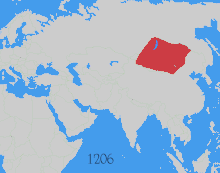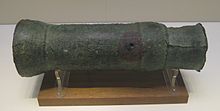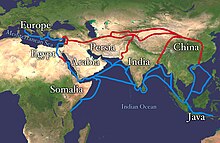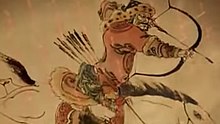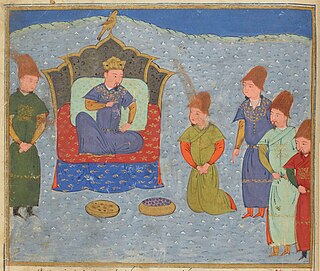
Batu Khan was a Mongol ruler and founder of the Golden Horde, a constituent of the Mongol Empire. Batu was a son of Jochi, thus a grandson of Genghis Khan. His ulus ruled over the Kievan Rus', Volga Bulgaria, Cumania, and the Caucasus for around 250 years.
Articles related to Mongolia include:
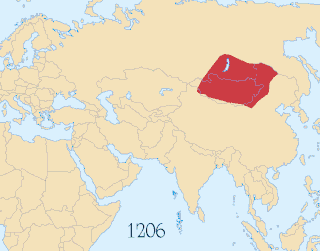
The Mongol Empire of the 13th and 14th centuries was the largest contiguous empire in history. Originating in present-day Mongolia in East Asia, the Mongol Empire at its height stretched from the Sea of Japan to parts of Eastern Europe, extending northward into parts of the Arctic; eastward and southward into parts of the Indian subcontinent, attempted invasions of Southeast Asia, and conquered the Iranian Plateau; and westward as far as the Levant and the Carpathian Mountains.

The Ilkhanate or Il-khanate, ruled by the Il-Khans or Ilkhanids, and known to the Mongols as Hülegü Ulus, was a Mongol khanate established from the southwestern sector of the Mongol Empire. The Ilkhanid realm was officially known as the Land of Iran or simply Iran. It was established after Hülegü, the son of Tolui and grandson of Genghis Khan, inherited the West Asian part of the Mongol Empire after his brother Möngke Khan died in 1259.

Ögedei Khan was the second ruler of the Mongol Empire. The third son of Genghis Khan, he continued the expansion of the empire that his father had begun.

Güyük Khan was the third Khagan of the Mongol Empire, the eldest son of Ögedei Khan and a grandson of Genghis Khan. He reigned from 1246 to 1248. He started his military career by participating in the conquest of Eastern Xia and then later in the invasion of Europe. When his father died, he was enthroned as Khagan in 1246. During his almost two year reign, he reversed some of his mother's unpopular edicts and ordered an empire-wide census; he also held some authority in Eastern Europe, appointing Andrey II as the grand prince of Vladimir and giving the princely title of Kiev to Alexander Nevsky.

Möngke Khan was the fourth khagan of the Mongol Empire, ruling from 1 July 1251, to 11 August 1259. He was the first Khagan from the Toluid line, and made significant reforms to improve the administration of the Empire during his reign. Under Möngke, the Mongols conquered Iraq and Syria as well as the kingdom of Dali.

Jochi Khan was a Mongol army commander who was the eldest son of Temüjin, and presumably one of the four sons by his principal wife Börte, though issues concerning his paternity followed him throughout his life. An accomplished military leader, he participated in his father's conquest of Central Asia, along with his brothers and uncles.
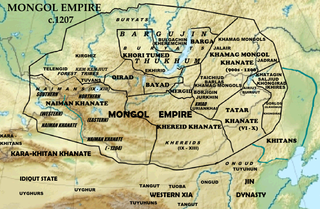
A Borjigin is a member of the Mongol sub-clan that started with Bodonchar Munkhag of the Kiyat clan. Yesugei's descendants were thus said to be Kiyat-Borjigin. The senior Borjigids provided ruling princes for Mongolia and Inner Mongolia until the 20th century. The clan formed the ruling class among the Mongols and some other peoples of Central Asia and Eastern Europe. Today, the Borjigid are found in most of Mongolia, Inner Mongolia and Xinjiang, and genetic research has shown that descent from Genghis Khan and Timur is common throughout Central Asia and other regions.

Sorghaghtani Beki or Bekhi, also written Sorkaktani, Sorkhokhtani, Sorkhogtani, Siyurkuktiti, posthumous name Empress Xianyi Zhuangsheng, was a Keraite princess and daughter-in-law of Genghis Khan. Married to Tolui, Genghis' youngest son, Sorghaghtani Beki became one of the most powerful and competent people in the Mongol Empire. She made policy decisions at a pivotal moment that led to the transition of the Mongol Empire towards a more cosmopolitan and sophisticated style of administration. She raised her sons to be leaders and maneuvered the family politics so that all four of her sons, Möngke Khan, Hulagu Khan, Ariq Böke, and Kublai Khan, went on to inherit the legacy of their grandfather.
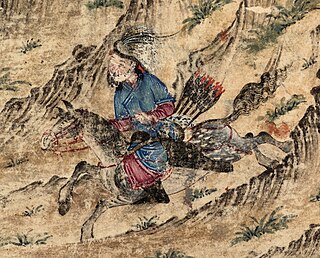
Yam was a postal system or supply point route messenger system extensively used and expanded by Ögedei Khan and also used by subsequent great khans and khans.

Mongols living within the Mongol Empire (1206–1368) maintained their own culture, not necessarily reflective of the majority population of the historical Mongolian empire, as most of the non-Mongol peoples inside it were allowed to continue their own social customs. The Mongol class largely lead separate lives, although over time there was a considerable cultural influence, especially in Persia and China.

In modern times the Mongols are primarily Tibetan Buddhists, but in previous eras, especially during the time of the Mongol empire, they were primarily shamanist, and had a substantial minority of Christians, many of whom were in positions of considerable power. Overall, Mongols were highly tolerant of most religions, and typically sponsored several at the same time. Many Mongols had been proselytized by the Church of the East since about the seventh century, and some tribes' primary religion was Christian. In the time of Genghis Khan, his sons took Christian wives of the Keraites, and under the rule of Genghis Khan's grandson, Möngke Khan, the primary religious influence was Christian.

The Yuan dynasty, officially the Great Yuan, was a Mongol-led imperial dynasty of China and a successor state to the Mongol Empire after its division. It was established by Kublai, the fifth khagan-emperor of the Mongol Empire from the Borjigin clan, and lasted from 1271 to 1368. In Chinese history, the Yuan dynasty followed the Song dynasty and preceded the Ming dynasty.

Kublai Khan, also known by his temple name as the Emperor Shizu of Yuan and his regnal name Setsen Khan, was the founder and first emperor of the Mongol-led Yuan dynasty of China. He proclaimed the dynastic name "Great Yuan" in 1271, and ruled Yuan China until his death in 1294.
Various nomadic empires, including the Xiongnu, the Xianbei state, the Rouran Khaganate (330–555), the First (552–603) and Second Turkic Khaganates (682–744) and others, ruled the area of present-day Mongolia. The Khitan people, who used a para-Mongolic language, founded an empire known as the Liao dynasty (916–1125), and ruled Mongolia and portions of North China, northern Korea, and the present-day Russian Far East.
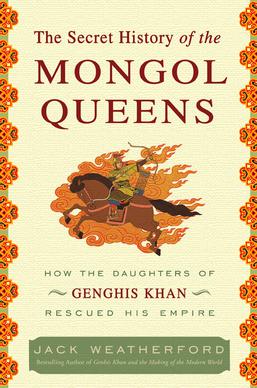
The Secret History of the Mongol Queens: How the Daughters of Genghis Khan Rescued His Empire is a 2010 book by Jack Weatherford, about the impact and legacy of Genghis Khan's daughters and Mongol queens such as Mandukhai the Wise and Khutulun. The book references Mongolian, Central Asian, Persian, European and Chinese sources such as Altan Tobchi, Erdeni Tobchi, Erdenyin Tunamal Sudar, Tarikh-i-Rashidi, Tarikh-i Jahangushay-i Juvaini, and Ming shi in addition to various secondary sources in English, Mongolian, and German.

The Mongols were highly tolerant of most religions during the early Mongol Empire, and typically sponsored several at the same time. At the time of Genghis Khan in the 13th century, virtually every religion had found converts, from Buddhism to Eastern Christianity and Manichaeanism to Islam. To avoid strife, Genghis Khan set up an institution that ensured complete religious freedom, though he himself was a Tengrist. Under his administration, all religious leaders were exempt from taxation, and from public service. Mongol emperors were known for organizing competitions of religious debates among clerics, and these would draw large audiences.
Checheikhen was a daughter of Genghis Khan and his first wife Börte.

Between 1205 and 1227, the Mongol Empire embarked on a series of military campaigns that ultimately led to the destruction of the Tangut-led Western Xia dynasty in northwestern China. Hoping to both to plunder and acquire vassalage, Genghis Khan commanded some initial raids against the Western Xia before launching a full-scale invasion in 1209. This was the first major invasion conducted by Genghis, and his first major incursion into China.

